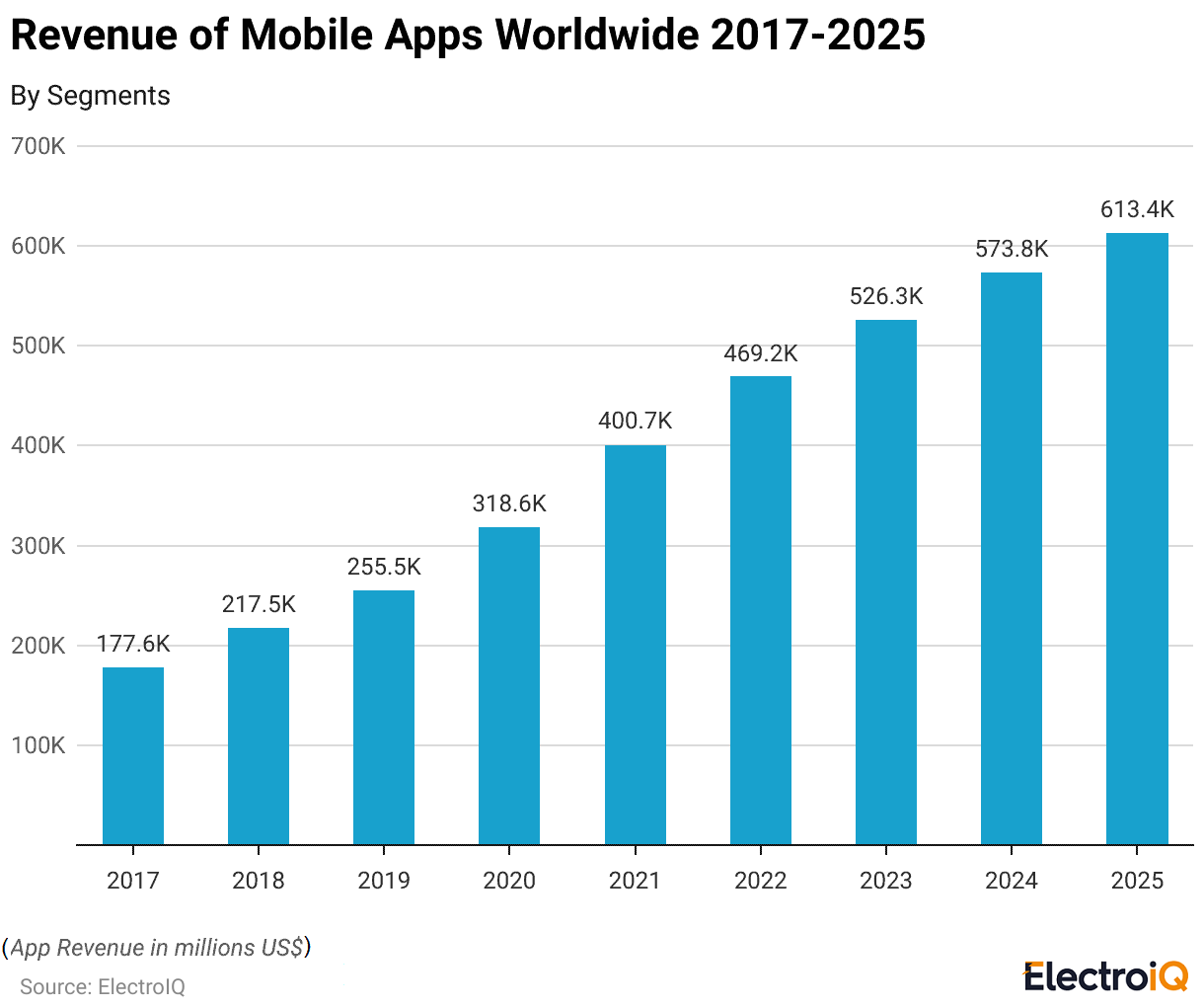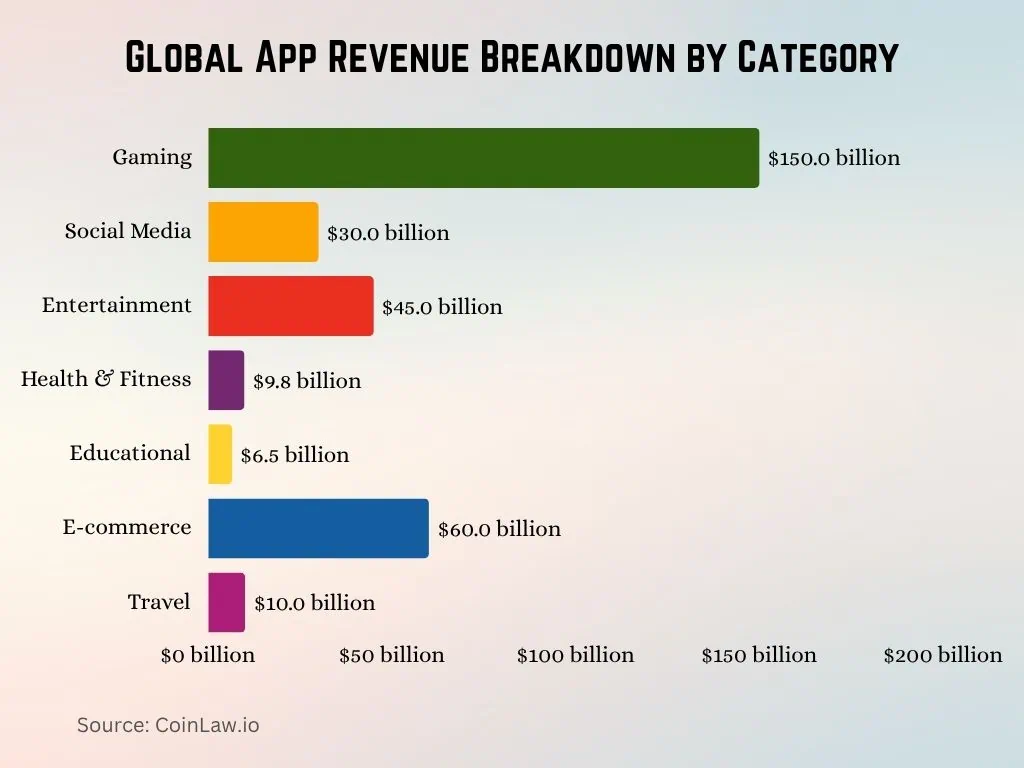App Revenue Statistics By Category, Insights And Facts (2025)
Updated · Nov 21, 2025

Table of Contents
- Introduction
- Editor’s Choice
- Mobile App Revenue
- App Revenue By Category
- Revenue by App Platform (iOS vs. Android)
- Global App In-Purchase Revenue
- Projected Global App Installs: Google Play vs App Store
- AI App Market Forecast Revenue
- Key Regional Insights (Asia, North America, Europe)
- Future Forecasts of the Mobile Application Industry
- Recent Developments
- Conclusion
Introduction
App Revenue Statistics: Mobile applications are turning out to be more and more beneficial for both sides – enterprises and individuals at the same time. The year 2024 has witnessed the app economy, which is the total spending by users plus the amount spent by advertisers to get to users, remaining very huge and to win in the most significant ways.
The year 2024 is not the end, but the beginning of the Mahapoos-like app economy, which has become a multibillion-dollar market, such as the one made up of soaring consumer spending, universal smartphone usage, and lightning-fast technological progress. It is hard to find a category that is not contributing to the growth – gaming, e-commerce, AI tools, and subscription services. This article is going to be all about the most influential app revenue statistics and forecasts.
Editor’s Choice
- Mobile app sales are expected to be up to US$613 billion by 2025, indicating a strong worldwide demand.
- The Google Play Store had 3.553 million applications in 2023, while the Apple App Store had 1.642 million.
- Users got 142.6 billion apps from the iOS App Store in 2022 and 110 billion from Google Play.
- Consumer spending on Apple’s App Store is estimated to reach US$161 billion by 2026; the total spending on both App Store and Google Play is expected to be US$233 billion.
- Just 5% of the total users are responsible for in-app purchases but generate a superior share of revenue, especially in Asia, North America, and Europe.
- In-app purchases represent 48.2% of the entire mobile app revenue; paid app downloads contribute to 37.8%.
- In 2025, gaming apps took US$150 billion (56% of all app revenue) and continued to be the leading revenue category.
- Social media apps made US$30 billion in 2025, with the support of advertising mainly.
- The total subscription services revenue of the entertainment applications made more than US$45 billion by the very popular apps of Netflix and Disney+.
- The iOS platform was the first in the revenue ranking with US$275 billion in 2025; the second place went to Android with US$225 billion.
- The worldwide in-app purchase sales were worth US$150 billion in 2024, which was almost a 13% increase from the previous year.
- The US was the largest contributor to IAP revenue with US$52 billion; Europe experienced the quickest growth of 24%.
- The total number of app installations worldwide is expected to be 230 billion by 2025, with the biggest app store, Google Play, contributing 187 billion.
- Revenue generated from AI apps showed a tremendous increase of 136% in 2024 and thus, reached US$4.5 billion and is forecasted to surpass US$156 billion by the year 2030.
- The Asia-Pacific area grabbed the lion’s share of the global app market with more than US$110 billion in 2025, out of which China accounted for approximately. 60%.
- According to the forecasts, global app revenue will be around US$600 billion by 2025, and mobile games will still be the largest segment.
- Install advertising spending for apps was reduced by 6% to US$82 billion in 2023 as a result of economic factors, with Android taking the hardest hit.
- Fitness applications such as Peloton and MyFitnessPal achieved good revenue growth by applying the hybrid subscription plus ad models.
- The total revenue of Cash App for the year 2022 was US$10.6 billion, which continued to grow in the year 2023.
Mobile App Revenue

(Reference: scoop.market.us)
- Mobile application revenue is still rising, and various forecasts show how big the industry has already gotten and how fast it is growing.
- Mobile app revenues have been estimated at US$613 billion by Statista for the year 2025, indicating that there is a strong demand for apps globally that cuts across all categories.
- There are already millions of alternatives in the app market waiting for users.
- In 2023, the Google Play Store had around 3.553 million apps for Android users, while the App Store had approximately 1.642 million apps for Apple users. Even older forecasts were already hinting at considerable growth.
- The mobile app market was said to be hitting US$935 billion in revenue by 2023, mainly due to the proliferated usage of smartphones, enhanced internet connection, and increased consumer spending in apps.
- In the case of using the apps, the download figures are too great to be ignored. Users of the iOS App Store were the ones who downloaded 142.6 billion apps in 2022, as reported by Business of Apps.
- Simultaneously, the Google Play Store noted 110 billion downloads for that year. The two platforms’ figures exhibit the enormous global demand for mobile applications.
- It is also anticipated that consumer spending in app stores will show a further increase in the future. According to Statista, spending on Apple’s App Store alone will be US$161 billion by 2026.
- When taking into account Google Play too, the global consumer spending on both stores is predicted to be US$233 billion by 2026.
- It is worth noting that a very small percentage of users, close to 5%, make in-app purchases, with the majority of the users making the purchase being in Asia, North America, and Europe, the highest revenue-generating regions.
- Analyzing the money-making strategies of apps, it is found that in-app purchases constitute the largest share of mobile app revenue, up to 48.2%.
- Around 37.8% comes from the second source, which is paid app downloads, thus demonstrating that the app developers who provide free apps for downloading are almost entirely dependent on in-app purchases—like upgrades, digital goods, and subscriptions—for revenue.
App Revenue By Category

(Source: coinlaw.io)
- The year 2025 marked a continuation of the trend of gaming apps being the largest in the mobile sector, as they accrued a mammoth sum of US$150 billion, which accounted for 56% of total app revenue.
- Along with that, social media was also a good performer, with apps such as Facebook and Instagram together producing US$30 billion by 2025.
- The main sources of this money were targeted advertising and in-app features that entice users to part with their money.
- The paying customers in the case of streaming services, for example, Netflix and Disney+, were responsible for over US$45 billion in income via subscription fees, thus proving that viewers are eager to spend on content that is considered top-notch and on ad-free viewing experiences of their choice.
- Also, health and fitness applications had a whopping growth rate of 40% in terms of revenue and had a contribution of more than US$9.8 billion to the overall app market.
- The increase is a clear indication of the rising appetite for digital wellness tools, fitness programs, and health monitoring amongst users.
- The education sector in general, especially the online learning segment, contributed to the revenue of the leading services like Duolingo and Khan Academy, which totalled US$6.5 billion in 2025.
- E-commerce apps formed a very large part of the overall revenue. The likes of Amazon and Shopify, among others, made more than US$60 billion, which was mainly because of in-app purchases and the ease of shopping on the phone.
- Also, the travel sector got back on its feet in 2025. Travel apps made US$10 billion, which was a quarter higher than in 2024 when people started more and more to buy tickets, lodgings, and vacation packages via mobile apps.
- All these numbers indicate that there was hardly any major app category in 2025 that had not been greatly increased, mainly due to the rising consumer spending, the growing dependency on mobile services, and the digital economy that keeps expanding.
Revenue by App Platform (iOS vs. Android)
- The iOS app market was the leader in 2025, as it had been in the previous years, and the global revenue brought in by it was around US$275 billion.
- Then came Android apps with US$225 billion, most of which occurred via the Google Play Store.
- If we observe the individual user spending, iOS users contributed a disproportionate income, showing an average revenue per user (ARPU) of US$138, as against Android users with US$72.
- The revenues for iOS gaming apps were US$90 billion, while Android gaming apps produced US$80 billion in the year 2025.
- The subscription app category was especially good on iOS, where the revenue amounted to US$50 billion through services like Apple Music and YouTube.
- Even though iOS made more money in total, Android’s growth rate was quicker in the underdeveloped areas. India was a very important part of this trend, and it helped Android to have a 20% growth rate in 2025.
- China also remained one of the strongest markets for Android, contributing more than US$75 billion from its various Android app stores.
Global App In-Purchase Revenue

(Source: techjury.net)
- In 2024, the worldwide in-app purchase income went up to US$150 billion, which is almost a 13% increase compared to the previous year and is the strongest growth seen since 2021.
- Non-gaming apps, in fact, did even better, with their IAP revenue increasing by 23%, whereas gaming apps experienced only around a 4% rise after two years of stagnation or decline.
- The US remained the largest in-app purchase market, producing US$52 billion, which corresponds to a 16% rise over the previous year.
- Europe, however, had the quickest growth overall, with IAP revenue climbing 24% due to significant increases in the UK, Germany, France, and Italy.
- These revenue increases did not lead to a corresponding increase in total app downloads, which remained flat at around 136 billion.
- This combined steadiness with higher spending indicates that users are putting more money into the apps they have rather than downloading new ones all the time.
Projected Global App Installs: Google Play vs App Store

(Source: coinlaw.io)
- Globally, app installs have experienced a steady increase between 2020 and 2025, and Google Play has been the largest contributor all along.
- The total number of apps downloaded by users in 2020 was 143 billion, where Google Play accounted for 109 billion installs and the App Store 34 billion.
- In 2021, the installs were projected to reach 155 billion, which would add 12 billion more downloads, the bulk being accounted for by Google Play with 119 billion, while the App Store would rise to 36 billion.
- By the year 2022, the predicted number of global app installs was 171 billion, out of which Google Play would be the source for 133 billion, while the App Store would account for 38 billion.
- The growth continued in 2023 when the total downloads were expected to be 188 billion, supported by 149 billion Google Play installs and 39 billion App Store installs.
- The strong growth trend remained in 2024, with the total number of installs expected to reach 209 billion.
- Google Play was supposed to draw in 168 billion downloads, while the App Store was set to reach 41 billion.
- 2025 was expected to see global installs hit 230 billion, with the share of Google Play at 187 billion and the App Store at 43 billion.
- This entire five-year timeline indicates a 10% compound annual growth rate (CAGR), thus proving the steady and reliable growth in mobile app downloads worldwide.
AI App Market Forecast Revenue

(Source: businessofapps.com)
- The revenue of AI apps experienced a dramatic increase in 2024, reaching US$4.5 billion, which is a whopping 136% rise compared to the previous year.
- The sudden escalation demonstrates how fast the public and businesses are opening up to AI tools. The revenue of AI apps will continue to grow steadily.
- As per the projections made, the revenue could surpass US$156 billion by 2030, which signals the rapid growth in the industry over the coming years as AI becomes an even more prominent feature in everyday apps and services.
Key Regional Insights (Asia, North America, Europe)
- In 2025, the Asia-Pacific region kept its position as the top global app market, earning over US$110 billion in total revenue.
- China was the main contributor to this, with nearly 60% of the region’s revenue share.
- North America was in second place with US$90 billion, mainly due to the high consumer expenditure in the US.
- Europe brought in US$70 billion, where the increase was particularly marked in the case of the countries of Germany and France.
- India was the clear winner in terms of growth with the phenomenal 40% year-on-year hike in app revenue, which was caused by the ever-growing mobile internet users and the acceptance of low-priced smartphones.
- Japan, on the other hand, had a considerable role in the Asia-Pacific region by making US$40 billion from the apps, mainly the games. The Latin American market was also very much alive, recording a 25% growth overall to a US$20 billion turnover, with Brazil and Mexico being the main driving forces behind it due to their high app consumption rates.
- On the other hand, while Africa and the Middle East were not the biggest markets, they still achieved the fastest growth of 45% by the developers taking an interest in the mobile-first users in these emerging markets.
Future Forecasts of the Mobile Application Industry
- Global app revenue, which is going up to US$600 billion by 2025, is likely to be the main source of income for the gaming industry, as the global marketplace continues to grow.
- The Asia-Pacific region will never lose its top market status, and it is going to provide more than 55% of the total revenue by 2026. It is mainly India to is the fastest-growing country in the region.
- According to the American reports, the continent will account for US$180 billion by 2026, with the subscription-based apps being the major source of revenue for developers.
- The in-app purchases will continue to be the largest contributor to app revenue at around 65% by 2025.
- It is also anticipated that emerging technologies will take up a larger part of the pie—metaverse and AR applications together could be bringing in more than US$50 billion by 2027, especially in social and gaming apps.
- Wearables, like those associated with smartwatches and health monitors, are expected to be responsible for US$10 billion in app revenue by 2025.
- Even the areas of Asia and North America are going to benefit a lot from the 5G rollout in terms of app performance and revenue, as it will enhance the gaming, video streaming, and AR experiences.
Recent Developments
- The mobile app industry has undergone several important transitions over time.
- Economic challenges across the globe forced companies to minimize their marketing expenditures, and as a result, app install ad spending experienced a 6% drop, and it is expected to be only US$82 billion in 2023.
- The decline of Android was more pronounced than the decline of iOS. Despite budget changes, mobile games that have been around for quite some time still did not lose their popularity – titles such as Minecraft, Hitman: Sniper, and Fruit Ninja Classic continued to rank among the highest-grossing games, proving that games with a long history still have large audiences attracted to them.
- There was good momentum in the fitness app segment, too. Companies like Peloton and MyFitnessPal have been able to successfully pair subscription models with free ad-supported features, which in turn leads to constant revenue growth from more people relying on mobile for monitoring their health and workouts, thus the apps contribute to that process.
- Cash App was another one that maintained its upward movement. The company, owing to the incorporation of such features as crypto, stocks, and trading, was able to bring in a 2022 revenue of US$10.6 billion, and the growth trend was continuous through 2023.
- In the wider market, the in-app purchases remained the biggest revenue stream, comprising 48.2% of total app revenue in 2020.
- Subscription models were adopted rapidly, and in the same period, their value increased by 34% year on year to approximately US$13 billion, which indicates that recurring payments have become more and more essential for app developers and platforms.
Conclusion
App Revenue Statistics: Overall, the mobile app economy is entering a new phase of accelerated growth, fueled by rising global spending, expanding digital adoption, and emerging technologies such as AI, AR, metaverse applications, and 5G connectivity. The dominance of gaming, the rapid rise of AI-powered apps, and strong regional performance—especially in Asia-Pacific—highlight how diverse and competitive the market has become.
As users spend more time and money within apps, revenue streams continue shifting toward in-app purchases and subscription models. Despite economic challenges affecting advertising budgets, the industry remains resilient and is on track to surpass major revenue milestones in the years ahead
FAQ.
The global mobile app revenue is forecasted to hit a figure between US$600 billion and US$613 billion by the end of 2025, all due to an increasing demand in the domains of gaming, social media, entertainment, and the new AI-enabled applications.
Apps for gaming will continue to be the most profitable ones, with a total revenue of up to US$150 billion in 2025, which is 56% of the total app revenue. Apps for entertainment are next, with more than US$45 billion coming from subscriptions, and mobile apps for social media are expected to generate approximately US$30 billion, primarily through ads. Mobile apps for e-commerce, travel, fitness, and education are also recording impressive growth.
No, that is a misconception. A mere 5% of the users make any in-app purchases, but this little band of users contributes to the majority of the revenue, especially in the Asian, North American, and European markets. In-app purchases account for 48.2% of the global mobile app revenue, and hence are the developers’ most favourite monetization approach.
The Asia-Pacific is the number one area worldwide with US$110 billion by 2025, and a long shot by China, which is ~60% of the region’s app spending. North America takes second place with US$90 billion, and Europe yields US$70 billion. Thus, India, Latin America, and Africa are becoming the fastest-growing markets.
Unbelievably. AI application revenue increased by 136% in 202,4, reaching US$4.5 billion with a projection of surpassing US$156 billion by the year 2030. The growth is mainly due to the large variety of AI-driven productivity tools, chatbots, photo/video enhancement apps, and virtual assistants that are available in the market.

I hold an MBA in Finance and Marketing, bringing a unique blend of business acumen and creative communication skills. With experience as a content in crafting statistical and research-backed content across multiple domains, including education, technology, product reviews, and company website analytics, I specialize in producing engaging, informative, and SEO-optimized content tailored to diverse audiences. My work bridges technical accuracy with compelling storytelling, helping brands educate, inform, and connect with their target markets.










